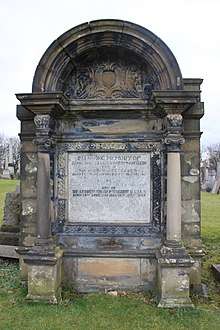Pettigrew & Stephens
Pettigrew & Stephens was a department store based in Sauchiehall Street, Glasgow.
History

In 1888, Andrew Hislop Pettigrew (1857-1942) and William Henry Stephens formed a partnership and opened a shop at 191-193 Sauchiehall Street (known as Manchester House) in Glasgow which Stephens already owned.[1] However, by 1896 William Henry Stephens had died, leaving Andrew Hislop Pettigrew in sole charge.[2]
By 1901, the store was rebuilt in a design by architects John Honeyman & John Keppie, with a gilt dome designed by Charles Rennie Mackintosh,[3] and sold a wide range of goods, including clothes, millinery, confectionery, carpets, furniture, ironmongery and china. In 1904, Andrew Hislop Pettigrew incorporated the company, and leased the Fine Art Institute building at 171-179 Sauchiehall Street, using it as a furniture department.
During 1914, the store was extended making it one of the biggest in Scotland,[4] with a further extension being added in 1923 to incorporate a specialist men's department.
In 1925, Andrew Hislop Pettigrew retired and sold his shares to Austin Friars Investment Trust Ltd, of London (a Clarence Hatry company), which in turn sold the business in 1926 to Scottish Drapery Corporation. The business was continued to be run as a separate company by the Scottish Drapery Corporation until 1952, when the Corporation and all of its subsidiaries were purchased by House of Fraser.[5]
The store continued to trade as Pettigrew & Stephens within the House of Fraser group, but its company status was wound up in 1955. In 1970, the store was moved from its location at 171-193 Sauchiehall Street to the site of Alexander Henderson, another department store recently bought by House of Fraser, as their site was earmarked for demolition (demolished 1971 - to make way for Sauchiehall Shopping Centre).[6][7] The business continued at its new location until it closed in 1974.
References
- "M124 Pettigrew & Stephens - Mackintosh Architecture @ University of Glasgow Website". Retrieved 14 November 2014.
- "House of Fraser Archive : Company: Pettigrew & Stephens". Retrieved 14 November 2014.
- "Sauchiehall Street - Glasgow History Website". Retrieved 14 November 2014.
- "House of Fraser Archive: Company:Pettigrew & Stephens Ltd". Retrieved 14 November 2014.
- "House of Fraser Archive: Company:Pettigrew & Stephens Ltd". Retrieved 14 November 2014.
- "House of Fraser: Company: Alexander henderson Ltd". Retrieved 14 November 2014.
- "Sauchiehall Street - Glasgow History Website". Retrieved 14 November 2014.